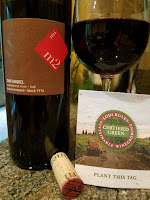Philippus Wolvaart, a German immigrant, purchased the beginnings of the estate in 1791, named it after his Commissioner-General, Sebastian Nederburgh, and soon planted wine grapes. The estate is located in the Paarl region that soon would become the heart of the South African wine industry until the focus shifted southwards to Stellenbosch in the later 20th century. According to Gavin Hubble, The Wine Guy, Paarl's "climate is very similar to the Rhône Valley in France, with moderate warm summers cooled by Atlantic breezes towards harvest season".
Over the years Nederburg changed owners but the real innovations started in 1937 when Johann Graue purchased the winery. He introduced cold soaking and other vineyard, cellar, and blending innovations which continued though legendary winemaker Gunter Brozel and continues to the present with Freeborough and her team of five winemakers.
During our lunch at Hank's Oyster Bar, Freeborough shared five wines that were not only delicious but excellent monetary values. The grapes for these wines were sourced from the best vineyards in Paarl as well as throughout South Africa. Whereas Germany is the winery's largest export market, Andrea hopes this trip moves the United State's closer to that threshold. Cheers.
 The Winemasters 2016 Chenin Blanc ($12, 13.5%). This is the latest wine in portfolio with the fruit sourced from cool climate vineyards. It provides very strong aromatics and acidity at the nose and the tail with a great mouthfeel in between. Thank 6 months on lees for that sensation. Great value.
The Winemasters 2016 Chenin Blanc ($12, 13.5%). This is the latest wine in portfolio with the fruit sourced from cool climate vineyards. It provides very strong aromatics and acidity at the nose and the tail with a great mouthfeel in between. Thank 6 months on lees for that sensation. Great value.
 The Young Air Hawk 2016 Wooded Sauvignon Blanc ($21, 14%). This wine pays tribute to Johann Graue’s son, Arnold who died tragically at 29 in a light aircraft crash but not before he had introduced many technical innovations at Nederburg. The grapes were sourced from selected cool climate vineyards in Elgin, Darling and Cape Agulhas, fermented in oak, and spent six months on their lees. The wine is very fresh, much fresher than you would think based on the winemaking techniques. Plenty of lemon aromas and flavors, mouthfeel, and finishing with abundant acids.
The Young Air Hawk 2016 Wooded Sauvignon Blanc ($21, 14%). This wine pays tribute to Johann Graue’s son, Arnold who died tragically at 29 in a light aircraft crash but not before he had introduced many technical innovations at Nederburg. The grapes were sourced from selected cool climate vineyards in Elgin, Darling and Cape Agulhas, fermented in oak, and spent six months on their lees. The wine is very fresh, much fresher than you would think based on the winemaking techniques. Plenty of lemon aromas and flavors, mouthfeel, and finishing with abundant acids.
The Anchorman 2015 Wooded Chenin Blanc ($21, 13%). This wine celebrates Nederburg’s founder Philippus Wolvaart and is a blend of Chenin Blanc (85%) and Grenache Blanc (15%). The Chenin grapes were harvested from old, low yielding, dry land bush vines in Wellington and Darling, while the Grenache Blanc grapes were harvested from trellised vines in Franschhoek. Separate batches of the fruit were fermented in various vessels with a portion fermented using carbonic maceration -- where whole bunches are allowed to ferment spontaneously without being crushed or pressed. And after malolactic fermentation, the various components were kept on the lees for 9 months prior to final blending. What a complex process, but the result is well worth the effort. The wine starts with a strong floral and fruit aroma, layered depth, and a long length. Fantastic.
 The Winemasters 2014 Pinotage ($12, 14.5%). The grapes were harvested from the Western Cape and after fermentation aged 12 months in various oak vessels including French, American and Romanian oak barrels. I loved this wine with it's subdued smokiness, balanced cherry fruit, and subdued acids and tannins. $12, really? That's it.
The Winemasters 2014 Pinotage ($12, 14.5%). The grapes were harvested from the Western Cape and after fermentation aged 12 months in various oak vessels including French, American and Romanian oak barrels. I loved this wine with it's subdued smokiness, balanced cherry fruit, and subdued acids and tannins. $12, really? That's it.  2014 The Brew Master ($22, 13.5%). This is a Bordeaux blend (Cabernet Sauvignon (51%), Petit Verdot (33%), Merlot (6%), Cabernet Franc (5%) and Malbec (5%) named in honor of Johann Graue who was also the co-owner of a German brewery before moving to South Africa. The grapes were fermented and aged separately in various French oak casks for two years. The blended wine is velvety smooth with juicy dark fruit and noticeable acids and tannins suitable for aging. Savory....
2014 The Brew Master ($22, 13.5%). This is a Bordeaux blend (Cabernet Sauvignon (51%), Petit Verdot (33%), Merlot (6%), Cabernet Franc (5%) and Malbec (5%) named in honor of Johann Graue who was also the co-owner of a German brewery before moving to South Africa. The grapes were fermented and aged separately in various French oak casks for two years. The blended wine is velvety smooth with juicy dark fruit and noticeable acids and tannins suitable for aging. Savory....







































